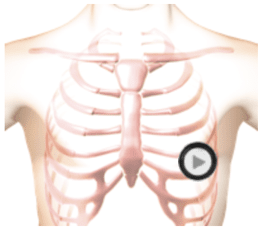Severe Mitral Stenosis Lesson
Where to Auscultate


The patient was supine left side down during auscultation.
Description
In this example of severe mitral stenosis, notice that the first heart sound has decreased intensity due to severe thickening of the mitral valve leaflets. The second heart sound is normal and unsplit, and systole is silent. An opening snap occurs 50 milliseconds into diastole. As mitral stenosis becomes more severe, the opening snap will occur earlier in diastole. The opening snap is followed by a low-frequency murmur which occupies the remainder of diastole. The first two-thirds of the murmur is diamond-shaped and the remainder is a crescendo.
Use the bell of the stethoscope to hear this murmur.
In the cardiac animation video, observe the turbulent blood flow from the left atrium into the left ventricle. Also notice the severely thickened mitral valve leaflets and the markedly enlarged left atrium. The excursion of the mitral valve leaflets is severely reduced. Mitral stenosis is commonly caused by rheumatic heart disease.
Phonocardiogram
Anatomy
Severe Mitral Stenosis
Authors and Sources
Authors and Reviewers
-
Heart sounds by Dr. Jonathan Keroes, MD and David Lieberman, Developer, Virtual Cardiac Patient.
- Lung sounds by Diane Wrigley, PA
- Respiratory cases: William French
-
David Lieberman, Audio Engineering
-
Heart sounds mentorship by >W. Proctor Harvey, MD
- Special thanks for the medical mentorship of Dr. Raymond Murphy
- Reviewed by Dr. Barbara Erickson, PhD, RN, CCRN.
-
Last Update: 11/10/2021
Sources
-
Heart and Lung Sounds Reference Library
Diane S. Wrigley
Publisher: PESI -
Impact Patient Care: Key Physical Assessment Strategies and the Underlying Pathophysiology
Diane S Wrigley & Rosale Lobo - Practical Clinical Skills: Lung Sounds
- PESI Faculty - Diane S Wrigley
-
Case Profiles in Respiratory Care 3rd Ed, 2019
William A.French
Published by Delmar Cengage -
Essential Lung Sounds
by William A. French
Published by Cengage Learning, 2011 -
Understanding Lung Sounds
Steven Lehrer, MD
-
Clinical Heart Disease
W Proctor Harvey, MD
Clinical Heart Disease
Laennec Publishing; 1st edition (January 1, 2009) -
Heart and Lung Sounds Reference Guide
PracticalClinicalSkills.com